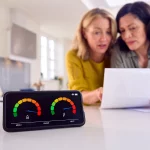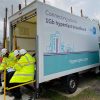New Study of UK 4G Mobile Cover Finds London is Best and Wales Fails
A new study from Which? and OpenSignal has used crowd-sourced data gathered from more than 28,841 Smartphone users (503 million tests) to reveal how 4G based Mobile Broadband availability and speeds vary across the United Kingdom, as well as between different network operators.
The study, which used data collected via OpenSignal’s Smartphone app between June 1st and August 31st 2016, also examined the comparative performance of older 3G data networks from each network operator and split the results by different regions of the United Kingdom.
Advertisement
Unsurprisingly EE (BT) ends up delivering the best overall 4G speeds and network coverage, which is largely because they own the most radio spectrum and had almost a full year’s head start on the roll-out. The latter is thanks to a decision by Ofcom that allowed them to use their existing 1800MHz band for 4G, while their rivals waited for the newer 800MHz and 2.6GHz.
Overall Results by UK Network Operator
| Operator | Avg. 4G Speed (Download) | Avg. 3G Speed (Download) | 4G Availability | 4G Latency |
3G Latency |
| EE (BT) | 28Mbps | 5.5Mbps | 64.1% | 41.09ms | 85.03ms |
| Vodafone | 18Mbps | 4.81Mbps | 60.1% | 43.48ms | 82.55ms |
| Three UK | 24.5Mbps | 6.1Mbps | 43.7% | 48.32ms | 85.71ms |
| O2 | 16.2Mbps | 4.11Mbps | 60% | 45.76ms | 91.08ms |
We’ve included the latency scores (response time in milliseconds between Internet servers) as this helps to demonstrate the huge improvement that modern 4G networks can deliver and is useful information, especially if you enjoy online multiplayer video games where latency (ping times) is crucial. A lower figure for latency is always best.
Elsewhere the coverage and performance of Vodafone and O2 UK’s network is very similar, which is in no small part due to their network sharing agreement (here). Three UK and EE also have a network sharing agreement, although it’s not quite as closely knit as the one held by their rivals and Three UK suffers (partly due to having a much smaller amount of spectrum to its name and also because of its data hungry customer base).
Overall 4G Availability and Speed by UK Region
| Region | 4G Availability | Average 4G Speed (Download) |
| London |
69.7% Advertisement |
18.8Mbps |
| Yorkshire & Humberside |
61.3% |
22.8Mbps |
| North East |
60.3% Advertisement |
20.1Mbps |
| Northern Ireland |
58.5% |
23.3Mbps |
| North West |
54.8% |
20.6Mbps |
| South East |
54.3% |
21.9Mbps |
| West Midlands |
52.3% |
21.6Mbps |
| Scotland |
50.4% |
21.1Mbps |
| East Midlands |
49.9% |
22.8Mbps |
| East of England |
48.9% |
22.3Mbps |
| South West |
45.7% |
20.9Mbps |
| Wales |
35.4% |
21.7Mbps |
It’s interesting to note that London is the best area for connecting to 4G, albeit only in terms of network availability because it also suffers from the lowest average 4G download speeds of all of the 12 UK regions reviewed in the report (18.8Mbps). By comparison Northern Ireland has both reasonable coverage (58.5%) and the best speeds at 23.3Mbps.
Sadly Wales had by far the worst coverage of all on 35.4%, but that’s hardly a surprise given the country’s large areas of sparse rural terrain and at least they weren’t the slowest region. The full report also displays the coverage for each region by operator, although for the most part EE comes top and the results tend to reflect the overall availability scores posted earlier.
Brendan Gill, CEO and co-founder of OpenSignal, said:
“There was a lot of good revealed in our data about U.K. operators. Mobile data speeds, both 4G and overall, were consistently fast in our tests throughout the country. But there definitely are still some areas in which the U.K. needs to improve. Finding a 4G signal outside of London can still be a bit tricky.”
Once again the results indicate that the coverage claims made by various mobile networks operators don’t always reflect the reality for end-users, although on that point it is important to note the limits of such crowd-sourced testing.
OpenSignal’s data was of course collected from various different makes of regular consumer Smartphone devices and recorded under conditions of normal usage. This is as opposed to drive-test data, which simulates the typical user experience by using the same devices to measure network performance in a small number of locations.
One problem with this approach is that you don’t have a solid base for comparison because every Smartphone has different strengths and weaknesses in terms of service performance and signal reception. Also it’s more difficult to accurately identify the exact circumstance of every individual test, such as whether somebody is indoors, on a roof / balcony or roaming around outside.
As the General Manager of RootMetrics, Scott Stonham, told ISPreview.co.uk this week, “Crowd collected data is good for some things, but using it in isolation to build a nationwide picture of mobile performance is prone to statistical uncertainty and bias. Consumers deserve an accurate assessment of the UK’s mobile operators’ performance, in order to do this information must be derived from the rigorous, independent and scientific collection and interpretation of fit for purpose data.” RootMetrics of course prefers the drive-test approach to data collection.
Ofcom are currently working with P3 to produce a similar report to the one that OpenSignal has today published and it will be interesting to see how this differs from today’s study, assuming they can gather enough data. We’d also like to see Ofcom do more to examine the differences between rural and urban mobile coverage, which is one area that everybody seems to avoid.
We should also add that 4G networks are still being rolled out in the UK, although most look set to complete their current deployments by the end of 2017, when around 97-98% of the population should be covered by the major mobile networks.
Mark is a professional technology writer, IT consultant and computer engineer from Dorset (England), he also founded ISPreview in 1999 and enjoys analysing the latest telecoms and broadband developments. Find me on X (Twitter), Mastodon, Facebook, BlueSky, Threads.net and Linkedin.
« Fixed Line ISPs and Three UK Call for Spectrum Cap on EE and Vodafone


















































Comments are closed